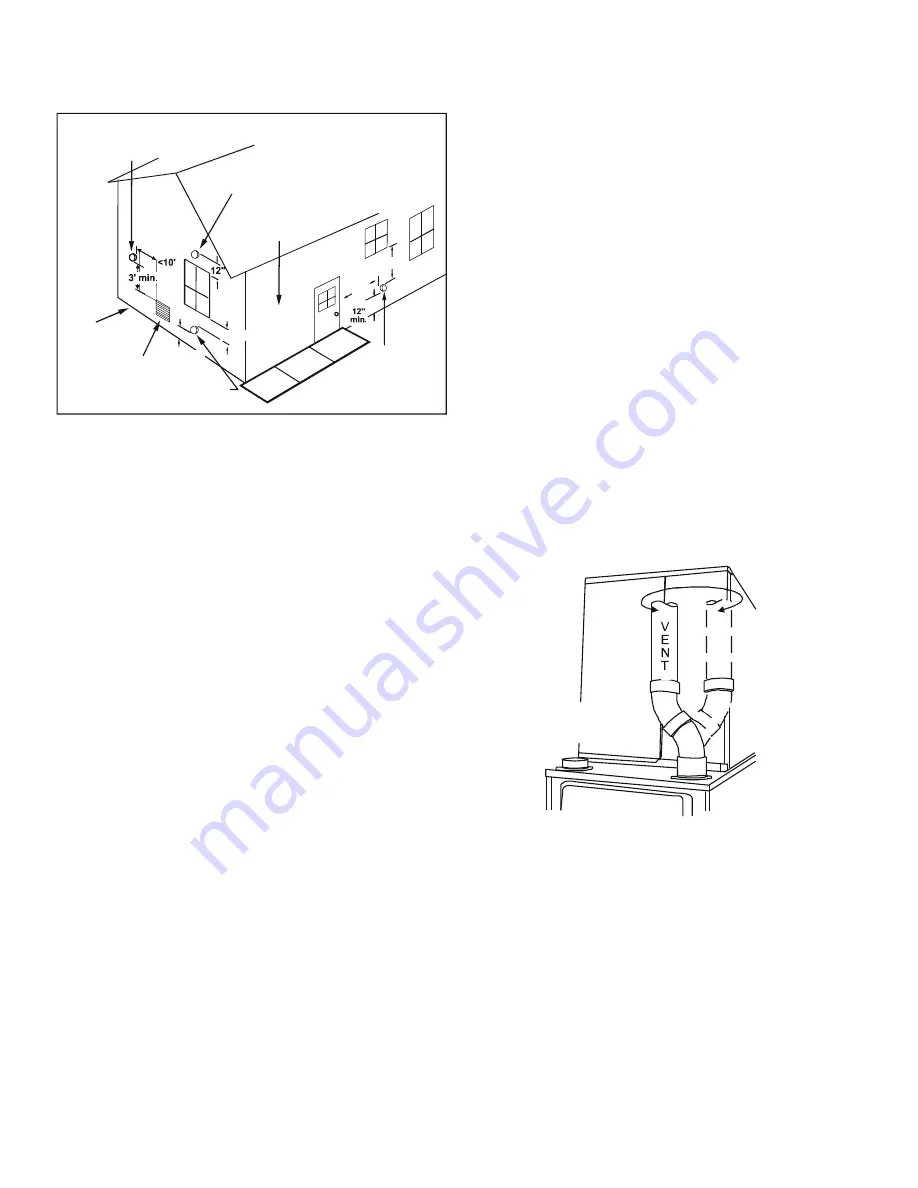
13
NOTE:
In Canada, the current edition of CAN/CSA B149.1-
15 takes precedence over the preceding termination
description.
Non-Direct Vent
Vent/Flue Termination
No Terminations
Above Walkway
4'
min.
Non-Direct Vent
Vent/Flue Termination
Direct Vent
Vent/Flue Termination
Forced Air
Inlet
Non-Direct Vent
&
Direct Vent
Vent/Flue Terminations
Grade or Highest
Anticipated
Snow Level
12" min.
4' min.
12" min.
Vent Termination Clearances
Figure 7
C
ANADIAN
V
ENT
P
IPE
& C
OMBUSTION
A
IR
P
IPE
R
EQUIRE
-
MENTS
All installations in Canada must conform to the requirements
of CAN/CSA B149.1-15 code. All vent components, including
primer and cement, must be listed to ULC S636. The certi-
fied pipe and fittings should be clearly marked with the ULC
standard “S636”. The primer and cement used must be of
the same manufacturer as the vent system. For Royal Pipe
System 636; use GVS-65 Primer (Purple) and GVS-65 PVC
Solvent Cement. For IPEX System 636, use PVC/CPVC Primer,
Purple or clear. Use PVC Solvent Cement (Gray).
For Canadian installations, ABS may be used as a combus-
tion air pipe only. ABS is not an approved vent material in
Canada. If ABS is used as a combustion air pipe, it must be
CSA certified. Always follow the manufacturer’s instructions
in the use of primer and cement. Do not use primer and
cement around potential sources of ignition. Do not use
primer or cement beyond its expiration date.
The safe operation, as defined by ULC S636, of the vent
system is based on following these installation instructions,
the vent system manufacturer’s installation instructions, and
proper use of primer and cement. It is recommended under
this standard, that the vent system be checked once a year
by qualified service personnel. All fire stops and roof
flashings used with this system must be UL listed. Accept-
ability under CAN/CSA B149.1-15 is dependent upon full com-
pliance with all installation instructions. Consult the au-
thority having jurisdiction (gas inspection authority, mu-
nicipal building department, fire department, etc.) before
installation to determine the need to obtain a permit.
*IPEX
System 636™ is a trademark of IPEX Inc.
Carefully follow the pipe manufacturers’ instructions for cut-
ting, cleaning, and solvent cementing PVC and/or ABS.
The vent can be run through an existing unused chimney
provided the space between the vent pipe and the chimney
is insulated and closed with a weather-tight, corrosion-re-
sistant flashing.
S
TANDARD
F
URNACE
C
ONNECTIONS
It is the responsibility of the installer to ensure that the
piping connections to the furnace are secure, airtight, and
adequately supported.
V
ENT
/F
LUE
P
IPE
The vent pipe outlet is sized to accept 2” pipe. Secure vent/
flue pipe directly into the furnace fitting with the appropriate
glue. Alternately, a small section of 2" pipe may be glued in
the furnace socket and a rubber coupling installed to allow
removal for future service. Combustion Air and Vent piping
should be routed in a manner to avoid contact with refrigerant
lines, metering devices, condensate drain lines, etc. If
necessary, clearances may be increased by creating an offset
using two 45 degree elbows. This joint can be rotated on
the fitting to establish maximum clearance between
refrigerant lines, metering devices, and condensate drain
lines, etc. This joint is the equivalent of one 90 deg. elbow
when considering elbow count. (See Figure 9A)
NOTE:
For
non-direct vent
installations, a minimum of one
90° elbow should be installed on the combustion air intake
coupling to guard against inadvertent blockage.
45 DEGREE
LONG-SWEEP
ELBOWS
Increased Clearance Configuration
Figure 9A
C
OMBUSTION
A
IR
P
IPE
D
IRECT
V
ENT
I
NSTALLATIONS
On
upflow
units secure the combustion air intake pipe to
the air intake coupling by using a take apart rubber coupling
supplied with the furnace or a plastic coupling. Also, the
intake coupling may be inverted to allow the intake pipe to
be glued directly to it. After inverting the coupling, secure it
to the furnace top with screws. On
counterflow
units secure
the combustion air intake pipe to the air intake coupling
using the rubber coupling and worm gear hose clamps provided
with the unit. The counterflow rubber coupling allows service
removal of air intake piping internal to the furnace blower
compartment. The combustion air intake pipe can also be













































